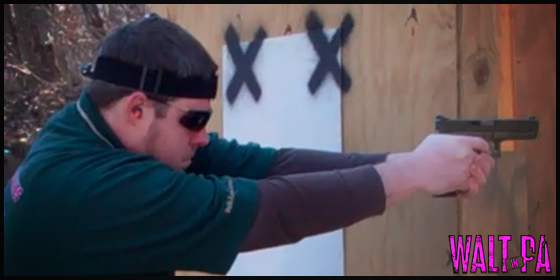
I began shooting USPSA in July of 2011, shooting my very first match at Topton Fish & Game. Ever since that match, I’ve been hooked on the sport. As much as I enjoyed it, though, USPSA Goals never crossed my mind. My sole intention at that point was to get out and shoot, having as much fun as I could while doing so.
By the time October rolled around, things began to change. My competitive drive kicked in and I began setting personal goals. I didn’t have a chance of winning a match at that time, and to be honest that thought never occurred to me, but getting classified was certainly within my reach.
The more I thought about it, I realized that anyone could become classified. I wanted more than just shooting enough classifer stages to move from “U” (Unclassified) to “D” class. I decided to push the envelope and strive for “C” class.
When the season ended and the USPSA Classification system updated in December, I was thrilled. I achieved my goal, just barely, and I was very proud of my accomplishment. With the season behind me, I sat down and thought long and hard about my USPSA Goals for the 2012 season.
The purpose of this post is to point out some of the things I’ve learned in the past year of competitive shooting. In addition, I would like to share some of my own goals and explain why they are important to me. With any luck, you’ll find something useful in this article and pass it along to someone you think may benefit from it as well.
USPSA Goals: Factors I Can’t Control
When I completed my rough draft of potential goals, I noticed a bit of a problem. My list contained items such as “Place in Top 50% at Club Level Match” and “Top 10 Finish on Single Stage Results”. While these goals would be fun and exciting, they didn’t allow for any real mesure of success.
I’m not saying that finishing in Position X doesn’t show achievement, I’m just saying that measuring your success is difficult because the means of that goal is out of your control. For instance, lets say that my goal is to break into the Top 10 on 3 separate occasions.
Lets go on to say that your club usually has a turnout of 30 Production Division shooters in mixed classifications. Ordinarily, breaking into the Top 10 would be difficult for a “C” class shooter such as myself. Difficult, but achievable.
As this fabricated scenario unfolds, one particular month brings about a twist. My usual 30 Production Division shooter turnout has turned into 50 shooters due to a highly popular match being held in the area, on the day after my match. These additional shooters thought it would be a good idea to head out early and shoot my match as practice for the following day.
Not only is the shooter pool larger, but I’m also competing against shooters at a higher classification than I’m accustomed to. My goal of placing in the Top 10 just went from being a struggle to simply beyond my reach. The same sort of problem occurs if I have the opposite scenario take place and the usual shooters at my club are out of town for a high profile match.
In this second situation, I’m in a better position to reach my goal. While I will be proud of my achievement, deep down inside it won’t be as important to me as if I were to place highly with the usual competitors in attendance.
The difficulty here is that I’m setting a goal for myself and I have no control over the factors that, in part, determine the outcome. It becomes more about who is standing in line at the registration table and less about how I am shooting.
USPSA Goals: Factors I Can Control
If we are on the same page, you have come to the realization that setting USPSA Goals based on a match finish is less beneficial to your shooting than basing those goals on factors you can control. Some of the things that can be controlled in a match environment are your hits. You may be thinking “That may be so, but I don’t know what any of the stages are going to look like ahead of time. Isn’t this just another unknown factor?”
The short answer to that question is Yes and No. While you typically will not know how club level matches will be set up ahead of time, the scoring of those stages is known and will not change. For instance, no matter how many targets are on the stage or how they are oriented, an A is an A and a Mike is a Mike.
Taking that known factor and expanding on it allows you to easily create two different types of goals. The first is the easiest and only requires you keep a mental count of your less desirable hits. For instance, if you want to allow yourself a maximum of 2 D Zone hits and a 0 Mikes, per match, all you have to do is listen while the Range Officer calls out the hits to the Score Keeper.
If you want to expand on your scores and put forth some additional work, you can set a goal of 90% Accuracy, or better. This is something that I do regularly and track at home, after match results have been posted. I not only track this information as a whole match, I look at it stage by stage as well.
When scores have been posted on the USPSA Website , I’ll go into each stage in my division and transfer some information into a spreadsheet. By taking my Raw Score, subtracting any Penalties, then dividing by the total stage points, I can convert the final number into a percentage to show me how I performed.
, I’ll go into each stage in my division and transfer some information into a spreadsheet. By taking my Raw Score, subtracting any Penalties, then dividing by the total stage points, I can convert the final number into a percentage to show me how I performed.

USPSA Goals – Walt’s Statistics for the May Match at Southern Chester – Click to Enlarge
While this method of goal setting isn’t as exciting as placing high in the match results, it will eventually lead to the same result. If I consistently shoot 90% of the available points in a given stage, in time my stage time will improve. As my accuracy remains consistent and my speed increases, my Hit Factor will climb, resulting in better placement with match results.
When I stopped focusing on my match placement and spent more time and effort analyzing my raw performance, I saw an immediate improvement in the match results. I went from telling myself “I hope I can pull out a Top 50% Finish” to “If I follow the plan, it will show in the results”.
USPSA Goals: Make Them Achievable
The most important aspect of setting goals for yourself, be it in the shooting sports or otherwise, is making those goals achievable. You want to set the bar high but at the same time make reaching those goals challenging. If you set the bar too low, the lack of challenge is going to bore you and you will ultimately set yourself up for failure. By the same token, if you set the bar too high, the lack of success in achieving those goals will ultimately result in failure.
Walt’s Unreachable USPSA Goals for 2012
- Climb from a “C” classified shooter to Master
- Double my average Hit Factor
- Become a USPSA Rockstar at my local club
I have found that the best results come from keeping my USPSA Goals achievable, but at the same time requiring constant effort. For instance, I am a C Class shooter striving to classify B. When I step up to the start position of a classifier stage, I take a deep breath and tell myself to shoot just a touch faster than I’m comfortable with but remain in control of my shots.
Each month when the classifications are updated, I see my average climb a little bit. Seeing progress and knowing that in a couple of months I should hit that B Classification keeps me focused on the prize as well as keeps me motivated. In my opinion, the best results are achieved by using your goals as a springboard to success. Once you finally reach that goal, take advantage of the proud moment and push your new goal out a bit further.
Walt’s Reachable USPSA Goals for 2012
- Climb from a “C” to “B” Class
- Maintain an accuracy of 90% – Average throughout the season
- Average less than 1 Penalty per Match
- Average less than 2 D’s per match
- Volunteer my time to help a local club
USPSA Goals: A Recap
By now you are probably sick to death of reading my thoughts on USPSA Goals. So rather than read a summary paragraph touching on everything I’ve already discussed, lets do a down and dirty list instead.
- USPSA Goals are an important part of progressing in this sport
- Create goals based on the factors you can control, such as your shooting, and not who shows up to shoot the match
- Set the bar high, but not so high as to result in a lack of motivation
- Set goals that challenge and keep you focused
- Use the proud moment of reaching a goal to set a new one, creating a situation of forward momentum in your skills
One last thing….
As I’ve mentioned in the above article, I am a C Class shooter and still relatively new to USPSA. I don’t claim to be an expert in goal setting or in shooting. My sole intention with this article was to share with you some of the things I’ve learned along the way, which have helped a great deal.
The inspiration for my USPSA Goals came from an NSSF Video by Doug Koenig. I then took that inspiration over to the Brian Enos Forum and recieved some great feedback
and recieved some great feedback on how to refine those goals.
on how to refine those goals.
If you’ve found this article useful, do me a favor and share it with your fellow shooters. Reader comments and incoming links go a long way in keeping me focused with this blog.
2 thoughts on “USPSA Goals – Setting Yourself up for Success”
Comments are closed.
Recent Posts
Why Fall is the Best Time for Motorcycle Riding (And How Summer Nearly Killed My Passion)
There's something magical about fall motorcycle riding that makes all the summer suffering worthwhile. As I sit here in my garage with a good cigar and a bourbon, looking at the cool September air...
From Group Ride Roasts to Real Life: My YouTube Channel Update
Well, my lovelies (I realize that sounds weird but at this point I need to lean into it), it's time for some real talk about where I've been and what's been happening behind the scenes at Walt in...

Walt Great article buddy, just got around to reading it now but very impressed, also been checking out your match videos you have really gotten good, and you’re speed has picked up ten fold. keep up the good work. This has been a very informative article
Corey,
Thanks for reading the article, I’m glad you enjoyed it.
The other day I decided to compare match video from last year to what I’m doing this year. It is amazing how much faster I have become.